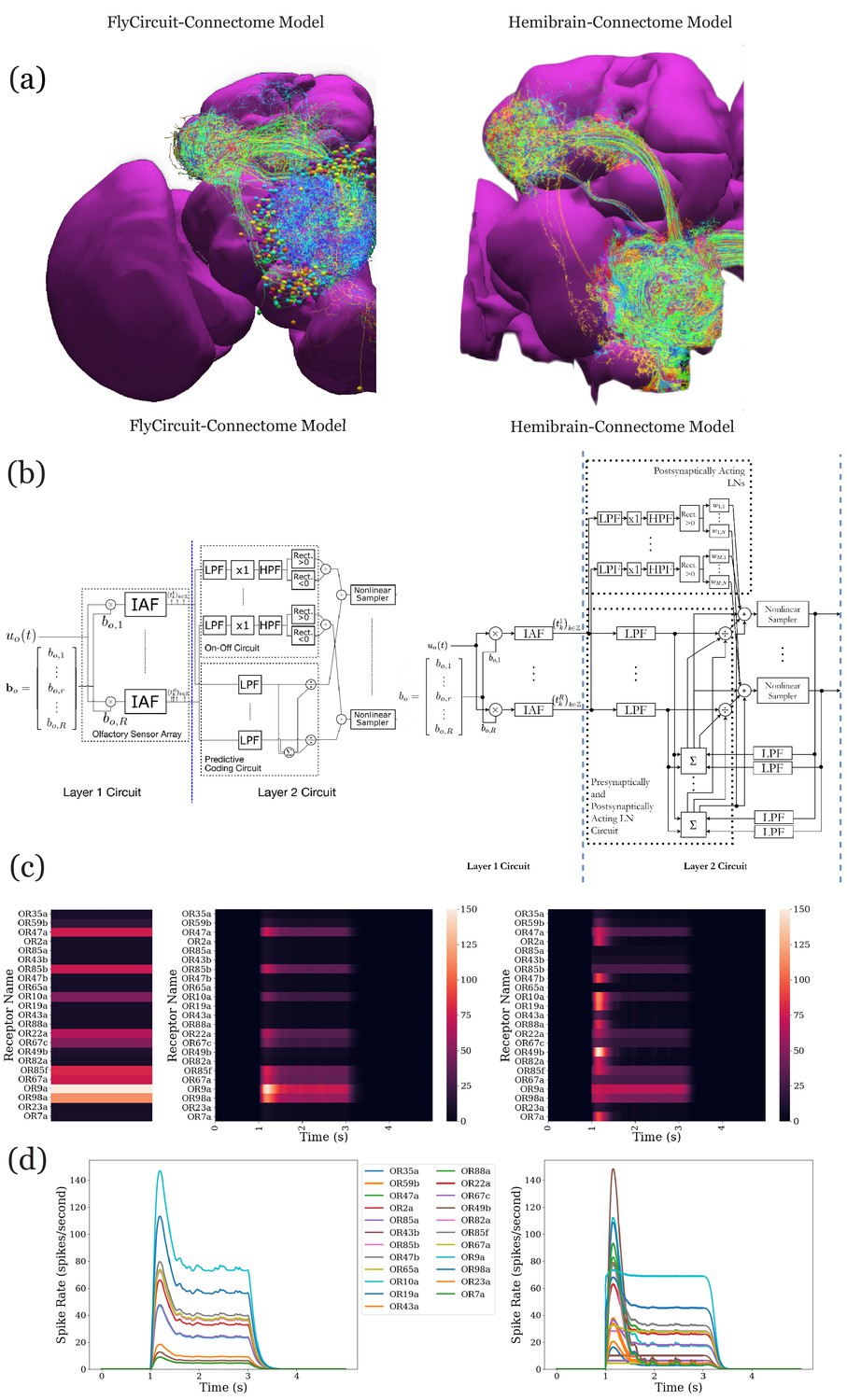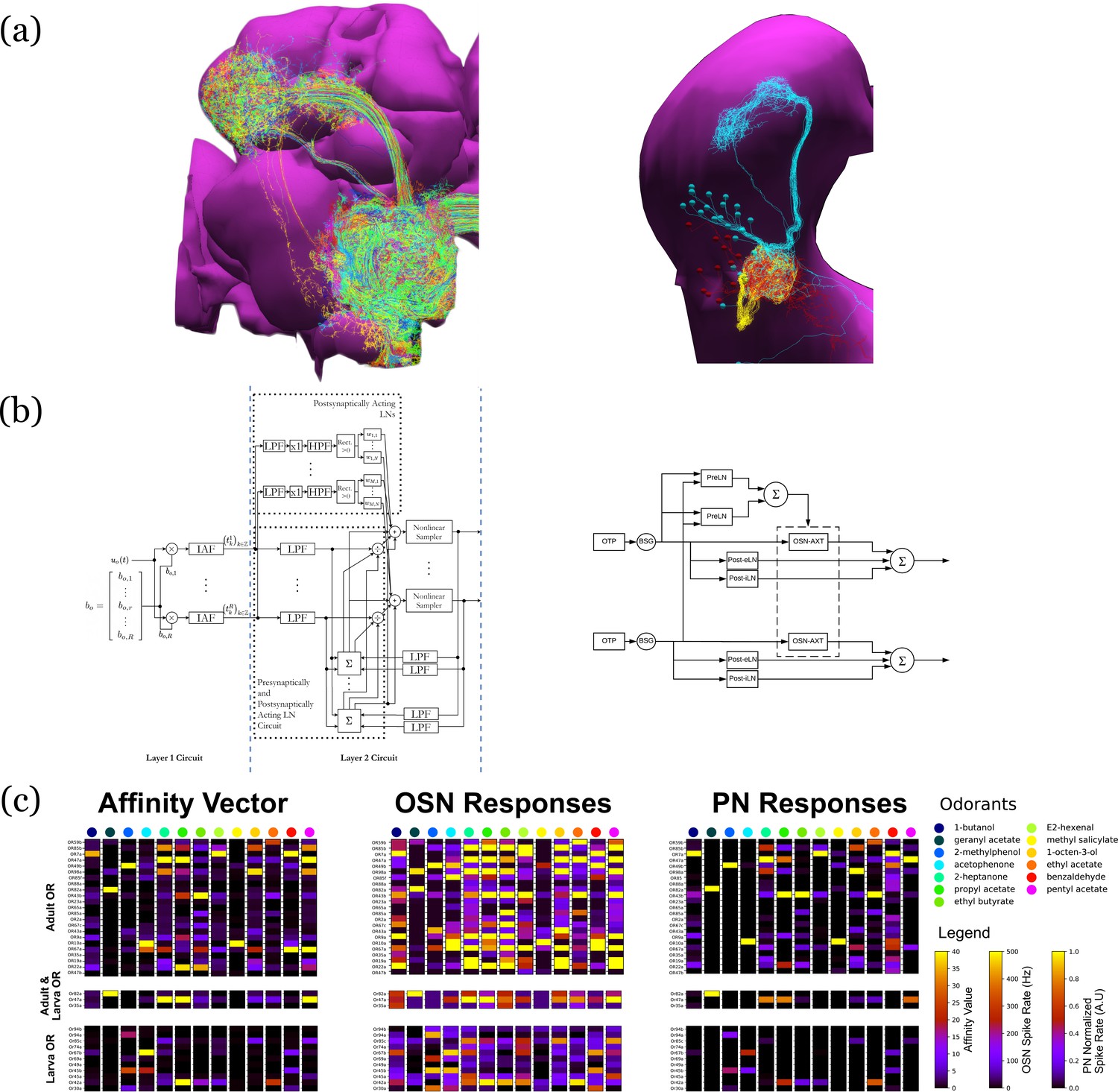The Functional Logic of the Odor Information Processing Circuits
Odorant mixture processing pathways of the Early Olfactory System (EOS) of the fruit fly brain are shown in the figure below (for credit, see Lazar et al., Frontiers in Physiology, 2024). The complex odorant environment (left) is first sensed by the Olfactory Sensory Neurons (OSNs) hosted in olfactory sensilla that are located on the Antennae and Maxillary Palps. Olfactory transduction takes place in the cilia of the OSNs through a transformation of chemical olfactory signals into electrical signals in the shape of action potentials.

The graph structural pathways of the EOS of the fruit fly are schematically shown in the figure below. OSNs expressing the same receptor type form a single channel. Antenna channels operate independently and in parallel, with the receptor map as the starting point of a parallel processing model. Note that, a more general parallel processing model operates in the antennal lobe. The Calyx features a major expansion of the Projection Neuron (PN) input to Kenyon Cell (KC) output connectivity.

The Odorant Encoding Machine (OEM), an executable circuit model of the EOS, is schematically shown below. The circuit architecture of the OEM consists of a cascade of spatio-temporal differential Divisive Normalization Processors (DNPs) each modeling the graph structural pathways of the Antenna, Antennal Lobe and Calyx.

The functional logic of the Antenna, Antennal Lobe and Calyx circuits is detailed below.
Odorant Transduction and Combinatorial Encoding in the Antenna
A key functionality of OSNs in the Drosophila Antennae is to jointly encode both odorant identity (semantic information) and odorant concentration (syntactic information). The identity (or semantics for short) of an odorant object is defined by the binding and dissociation rates of a given odorant-receptor pair, that is independent of the concentration waveform carrying syntactic information. The semantic and the syntactic information are multiplicatively coupled, i.e., combinatorially encoded, at the receptor level, leading to a confounding representation that can not be separated by single unit physiology recordings. To evaluate the I/O of the Olfactory Sensory Neurons, we modeled the fruit fly OSNs as a cascade consisting of an odorant transduction process and a biophysical spike generator. Open source code and documentation is available as part of the FlyBrainLab Odorant Transduction Library.
- Aurel A. Lazar and Chung-Heng Yeh, A Parallel Processing Model of Drosophila Olfactory Sensory Neurons and Its Biological Validation, bioRxiv, December 2017.
- Aurel A. Lazar and Chung-Heng Yeh, A Molecular Odorant Transduction Model and the Complexity of Spatio-Temporal Encoding in the Drosophila Antenna, PLOS Computational Biology, Volume 16, Number 4, April 2020.
- Aurel A. Lazar, Tingkai Liu, and Chung-Heng Yeh, An Odorant Encoding Machine for Sampling, Reconstruction and Robust Representation of Odorant Identity, ICASSP 2020, pp. 1743-1747, May 4-8, 2020, Barcelona, Spain.
Antennal Lobe Extracts Odorant Semantics and Semantic Timing Events
For temporal processing of odors along a single channel of the Antennal Lobe of the OEM, we modeled the presynaptic and postsynaptic Local Neuron (LN) pathways as temporal differential Divisive Normalization Processors, and demonstrated that the inhibition from Pre-LNs supports concentration invariance in PN responses, while Post-eLNs and Post-iLNs enhance the contrast-boosting. Extending the differential DNP model to a spatio-temporal differential DNP model, we showed that the panglomerular inhibition from Pre-LNs is also able to produce concentration invariant PN responses both across time and across channels. From a robustness standpoint, the odorant object identity recovery enabled by the Pre-LN pathway is robust across odorant object identity and concentration waveform profiles. Additionally, the Post-eLNs and Post-iLNs act as reliable event detectors capturing odorant onset and offset timing information across concentration waveform profiles.
- Aurel A. Lazar, Tingkai Liu, and Chung-Heng Yeh, An Odorant Encoding Machine for Sampling, Reconstruction and Robust Representation of Odorant Identity, ICASSP 2020, pp. 1743-1747, May 4-8, 2020, Barcelona, Spain.
- Aurel A. Lazar, Tingkai Liu, Mehmet K. Turkcan, and Yiyin Zhou, FlyBrainLab: Accelerating the Discovery of the Functional Logic of the Fruit Fly Brain in the Connectomic and Synaptomic Era, eLife 2021; 10:e62362, February 2021.
- Aurel A.Lazar, Mehmet K. Turkcan, and Yiyin Zhou, A Programmable Ontology Encompassing the Functional Logic of the Drosophila Brain, Frontiers in Neuroinformatics, April 2022.
- Aurel A. Lazar, Tingkai Liu, and Chung-Heng. Yeh, The Functional Logic of Odor Information Processing in the Drosophila Antennal Lobe, PLOS Computational Biology, Volume 19, Number 4, April 2023.
Functional Role of the Calyx
The OEM combinedly reduce the variability of the Calyx response to odorant concentration, thereby further separating odorant semantic information from syntactic information. We advanced a code, called first spike sequence code, that the KCs make available at the output of the Calyx. We have shown that the semantics of odorants can be represented by this code in the spike domain and is ready for easy memory access in the Mushroom Body compartments.
- Aurel A. Lazar, Tingkai Liu, and Chung-Heng Yeh, Odorant Encoding Machine for Sampling, Reconstruction and Robust Representation of Odorant Identity, ICASSP 2020, pp. 1743-1747, May 4-8, 2020, Barcelona, Spain.
- Aurel A. Lazar, Mehmet Kerem Turkcan, and Yiyin Zhou, A Programmable Model for Exploring the Functional Logic of the Drosophila Mushroom Body, bioRxiv, September 2022.
- Aurel A. Lazar, Tingkai Liu, Chung-Heng Yeh and Yiyin Zhou, Modeling and Characterization of Pure and Odorant Mixture Processing in the Drosophila Mushroom Body Calyx, Frontiers in Physiology: Invertebrate Physiology, Research Topic: Invertebrate Brains as Model Systems for Learning, Memory, and Recall: Development, Anatomy and Function of Memory Systems, Volume 15, October 2024.
Comparing Adult Antenna/Antennal Lobe Circuit Models based upon the FlyCircuit and Hemibrain Datasets
We depict below a comparison between two models of the antenna and antennal lobe circuit of the adult fly based on the FlyCircuit (left) dataset (Chiang et al., Current Biology, 2011) and an exploratory model based on the Hemibrain (right) dataset (Scheffer et al., eLife, 2020). For more details, see
- Aurel A. Lazar, Tingkai Liu, Mehmet K. Turkcan, and Yiyin Zhou, FlyBrainLab: Accelerating the Discovery of the Functional Logic of the Fruit Fly Brain in the Connectomic and Synaptomic Era, eLife 2021; 10:e62362, February 2021.

(a) Morphology of olfactory sensory neurons, local neurons, and projection neurons in the antennal lobe for the two datasets. The axons of the projection neurons and their projections to the mushroom body and lateral horn are also visible. (b) Circuit diagrams depicting the antenna and antennal lobe circuit motifs derived from the two datasets. (c) Response of the antenna/antennal lobe circuit to a constant ammonium hydroxide step input applied between 1 s and 3 s of a 5 s simulation; (left) the interaction between the odorant and 23 olfactory receptors is captured as the vector of affinity values; (middle and right) a heatmap of the uniglomerular PN PSTH values (spikes/second) grouped by glomerulus for the two circuit models. (d) The PN response transients of the two circuit models for uniform noise input with a minimum of 0 ppm and a maximum of 100 ppm preprocessed with a 30 Hz low-pass filter (Kim et al., J. Comp. Neuroscience, 2011) and delivered between 1 s and 3 s.
Comparing Early Olfactory Circuit Models of the Larva and the Adult Fruit Flies
We depict below a comparison of two Drosophila Early Olfactory System (EOS) models describing adult (left, developed based on Hemibrain dataset) and larval (right, developed based on LarvaEM dataset) circuits. For more details, see
- Aurel A. Lazar, Tingkai Liu, Mehmet K. Turkcan, and Yiyin Zhou, FlyBrainLab: Accelerating the Discovery of the Functional Logic of the Fruit Fly Brain in the Connectomic and Synaptomic Era, eLife 2021; 10:e62362, February 2021.

(a) Morphology of olfactory sensory neurons in the antenna, local neurons and projection neurons (PNs) in the antennal lobe. (b) Circuit diagrams depicting the antenna and antennal lobe circuit motifs. (c) (left) Interaction between 13 odorants and 37 odorant receptors (ORs) characterized by affinity values. The ORs expressed only in the adult fruit flies are grouped in the top panel; the ones that are expressed in both the adult and the larva are grouped in the middle panel; and those expressed only in the larva are shown in the bottom panel. Steady-state outputs of the EOS models to a step concentration waveform of 100 ppm are used to characterize combinatorial codes of odorant identities at the OSN level (middle) and the PN level (right).
In Vivo Recordings in the Early Olfactory System
We believe that the lack of a deeper understanding of how Olfactory Sensory Neurons (OSNs) encode odorants has fundamentally hindered progress in understanding olfactory signal processing in higher brain centers. Moreover, the lack of precise stimulus delivery and measurement systems has fundamentally limited the progress of functional identification in olfaction.
To address this limitation, we developed a novel in vivo experimental setup with precise and reproducible delivery of airborne stimuli. This experimental setup enabled us to apply system identification methods to OSNs in Drosophila. We applied time-varying odorant stimuli and recorded in vivo the response of Projection Neurons (PNs) postsynaptic to OSNs. These novel type of recordings have shown that individual OSNs and PNs encode the gradient and acceleration of odorant concentration waveforms, respectively. This research was performed in collaboration with Dr. Richard Axel in the Axel Laboratory.
- Anmo J. Kim, Aurel A. Lazar and Yevgeniy B. Slutskiy, System Identification of Drosophila Olfactory Sensory Neurons , Journal of Computational Neuroscience, Vol. 30, No.1, February 2011, pp. 143-161, Special Issue on Methods of Information Theory.
- Anmo J. Kim, Aurel A. Lazar, and Yevgeniy B. Slutskiy, Projection Neurons in Drosophila Antennal Lobes Signal the Acceleration of Odor Concentrations, eLife 2015;10.7554/eLife.06651, June 2015.
- Aurel A. Lazar and Chung-Heng Yeh, Functional Identification of an Antennal Lobe DM4 Projection Neuron of the Fruit Fly, Computational Neuroscience Meeting, Volume 15, July 2014, Québec City, Canada.
The Bionet Group is supported by grants from
 |
 |
 |
 |